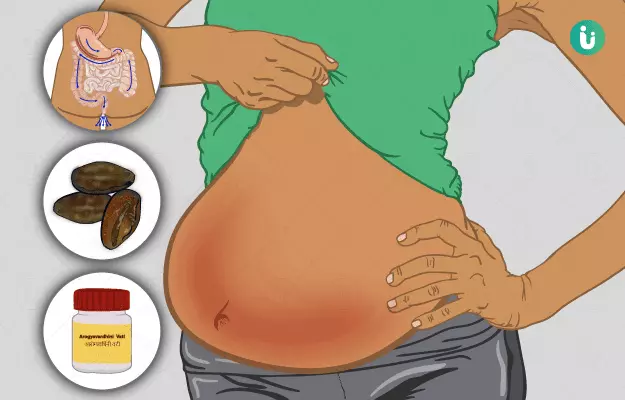Ascites, also known as jalodara, is a condition of the abdomen that occurs due to the accumulation of toxic fluid in the peritoneal cavity. As per Ayurveda, jalodara is a type of udara roga (disease of the abdomen), which is caused due to the accumulation of malas (waste products). This accumulated waste leads to the vitiation of doshas, prana vata (the main energizing force in the body), agni (fire component of the body) and apana vata (a type of vata). The signs and symptoms of ascites include abdominal distention along with swelling and pain in the abdomen. Ascites is commonly associated with hepatitis, liver cirrhosis and fatty liver. When detected in the early stages, it can be easily treated. Both medical and surgical treatments are suggested for ascites.
The main aim of treatment is the removal of the waste from the abdomen. This is achieved by nitya mridu virechana (the regular use of mild purgatives), which is one of the main therapies in panchakarma (five treatments). Diuresis is done using herbs that increase urine output, e.g., punarnava (red hogweed). Other herbs like pippali (long pepper) and haritaki (chebulic myrobalan) are also suggested. Ayurvedic formulations like shveta parpati (a herbo-mineral composition) and arogyavardhini vati (a classical polyherbal composition) are used in the treatment of ascites. In some severe cases, surgery may be advised. Restricted diet and regular treatment as per the advice of an Ayurvedic practitioner help in controlling the symptoms of the disease.
- Ayurvedic view of ascites
- Ayurvedic treatment for ascites
- Ayurvedic herbs and medicines for ascites
- Dietary and lifestyle changes for ascites patient as per ayurveda
- How effective are ayurvedic medicines and treatments for ascites
- Side effects and risks of ayurvedic medicine and treatments for ascites
- Takeaway
Ayurvedic view of ascites
Ascites, or jalodara, occurs due to the accumulation of toxic fluid in the peritoneal cavity. This causes blockage of bile secretions from the liver, resulting in liver enlargement. Most of the times, liver dysfunction or cirrhosis of the liver are the underlying causes for ascites. Jalodara is one of the eight different types of udara rogas. Udara rogas are caused due to the accumulation of malas like faeces, urine and sweat in the body. In addition to this, there is a dominance of a vitiated dosha, which causes poor digestion and slow metabolism. The main reason for the accumulation of waste is constipation. Similarly, excess intake of water can worsen digestion and result in the accumulation of the doshas that vitiate prana vata, agni and apana vata. The vata in the lower left stomach and duodenum gets blocked by kapha, resulting in the accumulation of fluid in the peritoneum and distention of the abdomen.
The main signs and symptoms of ascites are pain in the abdomen, excessive thirst, loss of appetite, difficulty in breathing, and discharge from the anus. The abdomen sounds hollow on tapping. The condition requires immediate intervention, as it becomes difficult to treat ascites once the fluid begins to accumulate in the peritoneum. The accumulated fluid liquefies the doshas and causes stickiness in the joints. Accumulation of fluid causes the abdomen to become round, and a network of blood vessels can be seen on the abdomen accompanied by oedema on the feet.
Ascites can be healed easily in the early stages with the help of Ayurvedic medicines containing punarnava, pippali (long pepper), trikatu (a combination of the three acrids – pippali [long pepper], shunthi [dried ginger] and maricha [pepper]), triphala (a combination of amalaki [Indian gooseberry], vibhitaki [belleric myrobalan] and haritaki), chitraka (leadwort) and sesame oil.
Fluid regulation and diet control are very useful in controlling the disease at an early stage. Thus, the treatment aims at deepana (increasing hunger) and pachana (improving digestion). Swedana (sudation) and nitya mridu virechana are advised as shodhana karma (purification therapies) in panchakarma.
If the condition is still not corrected with medications and herbs, then severe complications can develop, and surgery may be suggested.
Ayurvedic treatment for ascites
- Snehana (oleation)
- Oleation therapy is advised only if you are strong and able to tolerate the treatment.
- Generally, in the case of jalodara, snehana is contraindicated as the abdomen is distended and painful. Neither is it recommended in case of aggravated kapha dosha.
- In case of ascites, snehana makes a pretreatment, to be performed before the actual panchakarma, and involves massaging the body using oils to pacify the vata dosha. Narayana taila and dashmoola taila may be used for snehana for the treatment of ascites.
- Snehana is done for a total period of 15 to 35 minutes at a time.
- Avoid walking in cold weather, abstain from sexual activity and avoid speaking loudly after the treatment.
- Swedana
- Swedana is a pretreatment procedure as well.
- In ascites, swedana is done to remove the toxins accumulated due to the blockade of circulatory channels.
- In this procedure, perspiration is induced with the help of steam and vapours of herbal decoctions.
- The process should be done in the presence of an Ayurvedic practitioner, and, after the therapy, blood pressure and pulse rate should be monitored.
- Virechana
- Virechana is the process of inducing purgation to remove toxins from the body. Nitya mridu virechana is suggested in case of ascites.
- A mild purgative agent such as castor oil can be given daily to empty the contents of the stomach and, thus, remove the toxins accumulated in the abdomen.
- Oil of danti (wild castor) may also be given with saindhava lavana (rock salt) every night after meals.
- Mild purgation done on a daily basis will take care of constipation and avoid the accumulation of toxins.
- Katuki (kutki) is also widely used along with eranda (castor) for purgation.
- In some cases, abhayadi modaka, which contains pippali, mustaka (nutgrass), danti, and trivrit (Indian jalap) as the main ingredients, is used for nitya virechana.
- Shastra karma
- Shastra karma refers to the surgical treatment of a condition. It is only employed when the condition is not controllable with medicines.
- Surgery is usually done after removal of the vitiated vata dosha.
- An incision is given on the left side of the abdomen below the umbilicus, using the vrihimukha, a surgical instrument.
- A metallic tube is then inserted through the puncture, and the accumulated fluid is drawn out. All the accumulated fluid is not removed at once, but the procedure is repeated after a few days depending on the rate of accumulation of the fluid.
- The puncture site is then lubricated with oil and bandaged.
- Direct administration of water is strictly prohibited after surgery. A light diet is given with milk. A gruel or soup based diet is usually suggested post surgery.
Ayurvedic herbs and medicines for ascites
Ayurvedic Herbs for Ascites
- Punarnava
- The entire herb and sometimes the roots of punarnava are used in the treatment of ascites.
- Punarnava has a good diuretic activity and is also a laxative (regulates bowel movements); hence, it is used in conditions like ascites to relieve oedema due to the accumulation of fluids.
- It is used as a churna (powder) or kwatha (decoction).
- Pippali
- The powdered fruit of pippali is used in the treatment of ascites.
- Pippali fruits have tikshna (incisive) properties and increase hunger as they stimulate the digestive fire. All these properties are responsible for improving digestion and pacifying the vitiated kapha dosha in ascites.
- Pippali also improves appetite and has hepatoprotective properties (protects and improve liver function); hence, it is a drug of choice in the treatment of ascites when the condition is associated with liver cirrhosis.
- It offers relief from abdominal distention and oedema on the feet.
- Administration of pippali as a vardhamana pippali rasayana is a very effective type of treatment in which graded doses of pippali are given to alleviate ascites symptoms.
- Haritaki
- The fruits of haritaki are used to treat ascites.
- Haritaki improves digestion. It also has a mild laxative effect that helps in expelling the malas out of the body.
- For the treatment of ascites, haritaki is given with gomutra (cow urine), this formulation has deepana (hunger-increasing) and pachana (digestive) properties, which helps improve digestion.
Ayurvedic Medicines for Ascites
- Punarnavadi kwatha
- It is a polyherbal composition consisting of punarnava as its primary ingredient.
- It also contains daruharidra (Indian beriberi), mustaka, haridra (turmeric), nimba (neem), guduchi (heart-leaved moonseed), shunthi, and katuki.
- Punarnava has a diuretic effect, which is necessary to remove excess water and accumulated toxins, thereby, reducing oedema. Katuki acts as a purgative, while nimba is a detoxifier.
- Mustaka, haridra and daruharidra help in removing the vitiated doshas and relieve the symptoms of ascites. Guduchi helps to restore health.
- Phalatrikadi kwatha
- It is a decoction prepared from eight different herbs.
- It contains triphala, guduchi, vasa (malabar nut), bhunimba (green chiretta), nimba and katuki.
- Vasa is responsible for removing kapha dosha while nimba and bhunimba are detoxifiers.
- Katuki is a liver tonic that helps to treat cirrhosis, which may be a cause for ascites.
- Triphala also has a cleansing action and helps to relieve constipation.
- This formulation, when taken with honey, helps in treating liver-related ascites.
- Arogyavardhini vati
- Arogyavardhini vati is a classical Ayurvedic formulation, which consists of haritaki, vibhitaki, amalaki, shilajatu (asphaltum), guggulu (Indian bdellium tree) eranda (castor), katuki, nimba and the metals parad (mercury), sulphur, lauha bhasma (calcinated iron), abhraka bhasma (calcinated mica) and tamra bhasma (calcinated copper).
- This preparation has hepatoprotective properties and is useful in liver disorders and ascites associated with liver disorders.
- Katuki and eranda produce purgation, thereby helping remove toxins from the body.
- Although it contains mercury and sulphur, its safety and efficacy have been proven.
Urjas Shilajit from myUpchar Ayurveda may provide support in managing ascites. Its natural properties promote overall health.Order Shilajit Capsules and Shilajit Resin now
- Shveta parpati
- This is a herbo-mineral combination used to treat ascites.
- It is commonly included in the treatment regimen in its churna form.
- The formulation contains sharapunkha (wild indigo), bhumiamalaki (stonebreaker), navasara (ammonium chloride), surya kshara (potassium nitrate) and sphatika (alum).
- The preparation mainly promotes diuresis and thus reduces oedema.
- Bhumiamalaki helps in treating hepatitis and sharapunkha is used for the treatment of liver cirrhosis.
Dietary and lifestyle changes for ascites patient as per ayurveda
Do’s
- A milk diet is typically advised; the milk can be of a cow, goat or camel. (Read more: Goat milk benefits)
- Consume old rice with mudga (green gram).
- Consume vegetable soup.
- Have a light, easy-to-digest diet with ingredients such as yavagu (gruel), karela (bitter gourd).
- Take timely meals.
- Go for nitya mridu virechana under the guidance of an Ayurvedic practitioner.
Don’ts
- Salt and water intake should be reduced.
- Do not take heavy foods such as peas, black-eyed beans, lentils and yellow gram.
- Do not eat raw vegetables and salads.
- Do not consume items made from maida (refined flour).
- Do not eat sprouts.
- Do not sleep during the daytime.
- Avoid stressful physical activities.
- Stay away from mental stress.
How effective are ayurvedic medicines and treatments for ascites
Jalodara or ascites is a type of udara roga, and most of the times it is caused due to liver disease. Ayurvedic treatment for this condition aims at improving digestion and avoiding constipation. Regular use of mild purgatives is advised for the same. Herbal formulations to improve digestive agni along with hepatoprotective drugs are commonly used in the treatment regimen of ascites and have proven to be safe and effective.
A research study was done on 56 patients by giving them vardhamana pippali rasayana, which is a regimen of increasing and tapering pippali doses. Preparatory treatment involved purgation using katuki. Diuresis was promoted using punarnavadi kwatha. The patients were monitored regularly for urine output and girth of the abdomen. Liver function tests were regularly performed. At the end of the study, all the patients showed increased urine output, decreased girth of the abdomen and improved liver function tests. Thus, the treatment was found to be effective and safe.
In another study, a single patient, a 45-year-old female, was undergoing treatment for ascites. She was given nitya virechana, and Ayurvedic formulations were administered orally. For nitya virechana, abhayadi modaka was given to the patient, and arogyavardhini vati was given for 45 days. Her oedema decreased considerably, and her symptoms improved without any side effects. Metallic preparations were also found safe in proper doses.
Side effects and risks of ayurvedic medicine and treatments for ascites
Ascites, characterised by the accumulation of fluid in the abdomen is the most common manifestation of liver disease. A variety of herbal preparations are used to treat the condition. The treatment can be effectively given without any noted side effects. Use of metals in Ayurvedic drugs has also been reported as safe and efficacious. Only in complicated cases of ascites, surgery is suggested. Mild virechana is given to prevent dehydration. Liver enzymes are continuously monitored throughout the treatment. When given in proper doses these medicines are suggested to be safe.
People who have existing liver problems are at a greater risk of ascites. Similarly, constipation or excessive water intake can result in agnimandya (reduced digestive fire), which can further increase the risk for this condition.
Takeaway
Jalodara or ascites is a disease in which toxic fluid accumulates in the abdomen, resulting in abdominal distention, pain and oedema. The condition requires immediate treatment to avoid worsening of the disease. Ayurvedic treatment for ascites aims at removal of the vitiated doshas responsible for the condition. Virechana karma carried out on a regular basis helps to remove toxins from the body, and its laxative effect also improves the agni. Herbal medicines cleanse your body by increasing urine output and also improve liver dysfunction, which is the main cause of the disease. Following the dietary restrictions strictly and taking regular medications can help keep the condition under control.
Find Ayurvedic Doctor in cities
Doctors for Ayurvedic medicine, treatment and remedies for Ascites

Dr. Ayush Bansal
Ayurveda
2 Years of Experience

Dr. Megha Sugandh
Ayurveda
6 Years of Experience

Dr. Nadeem
Ayurveda
3 Years of Experience

Dr.Ashok Pipaliya
Ayurveda
12 Years of Experience
References
- Swami Sada Shiva Tirtha. The Ayurveda Encyclopedia. The Authoritative Guide to Ayurvedic Medicine; [Internet]
- Ministry of AYUSH, Govt. of India. Ayurvedic Standard Treatment Guidelines. [Internet]
- Lakshmi Chandra Mishra. Scientific Basis for Ayurvedic Therapies. U.S. Government; [Internet]
- The Indian Medical Practitioners Co-operative Pharmacy. Vaidya Yoga Ratnavali. Madras; 1968
- Shital Gopalbhai Bhagiya et al. A single-case study of management of Jalodara (ascites). Year : 2017 Volume : 38 Issue : 2 Page : 144-147
- Central Council for Research in Ayurvedic Sciences. Diseases. National Institute of Indian Medical Heritage; Hyderabad
- G. Aswathy et al. Ayurvedic management of cirrhotic ascites. Anc Sci Life. 2016 Apr-Jun; 35(4): 236–239. PMID: 27621523
- Kurt Lenz et al. Treatment and management of ascites and hepatorenal syndrome: an update. Therap Adv Gastroenterol. 2015 Mar; 8(2): 83–100. PMID: 25729433
- Department of Kayachikitsa et al. Critical Analysis of Jalodara(Ascites). Journal of Ayurveda and Integrated Medical Sciences; [Internet]
- Manish V. Patel et al. A Complex Multiherbal Regimen Based on Ayurveda Medicine for the Management of Hepatic Cirrhosis Complicated by Ascites: Nonrandomized, Uncontrolled, Single Group, Open-Label Observational Clinical Study. Evidence-Based Complementary and Alternative Medicine; Volume 2015, Article ID 613182, 12 pages
- Panda AK et al. Ayurvedic Intervention for Hepatobiliary Disorders: Current Scenario and Future Prospect. Central Ayurveda Research Institute of Hepatobiliary Diseases, Bhubaneswar, Odisha









